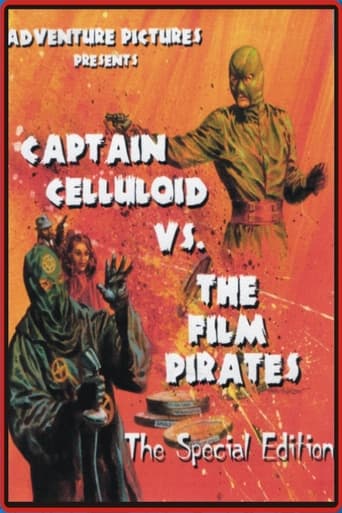larry41onEbay
This fun little low budget film was made by classic film buffs for classic serial buffs. Back when most classic film festivals were being held by a handful of friends in private home basements and garages. there was talk of an evil Master Duper. Film buffs did not have videotape and the TV late show did not play every film ever made, they had to go looking elsewhere. Thank goodness (a.k.a. Captain Celluloid) Blackhawk, Castle and Film Classics made 8mm and 16mm available for home use. Today, thanks to cable TV, video, DVD, IMDB and (God love them for keeping the search for forgotten films going) classic film festivals more and more titles are being saved from oblivion everyday! SUPPORT FILM PRESERVATION!!!!!!!
Tom Fowler
Sinister Cinema says that Captain Celluloid, `deserves consideration as the best amateur film ever made.' However, in his excellent 1977 salute to the serials, `Cliffhanger,' Alan G. Barbour notes that director Louis McMahon was a `top-flight cameraman.' Certainly this is not hard to believe when one views Captain Celluloid. For those of us familiar with 1940's era Republic serials, the story behind the film is more interesting than the film itself. Shot in the mid 1960's by an impressive group of serial buffs, including film historians Barbour and William K. Everson, Captain Celluloid came along when an attempt was being made to re-introduce the serials to the younger generation. Sadly, this did not pan out as hoped but we can be grateful that, since that time, the classic serials have become readily available on VHS and DVD. Less than an hour in length, the story line pokes gentle humor at the Republic serials and one does indeed notice a rich Republic flavor. Captain Celluloid spends four chapters keeping rare film prints away from the heavily disguised Master Duper, who Barbour admits was portrayed by himself in Cliffhanger, even though the Master Duper turned out to be another character in the story, not Barbour's. Barbour's wife Jean had a small but delightful, over-the-top role as Satanya, an evil villainess who supplies the Master Duper with his instruments of mischief. (a super fast film copier and an invisibility machine). Larry Clayton in the lead was superb and I enjoyed Grant Willis as Tom the Truckman, who milked it for all it was worth when getting shot in the face. Captain Celluloid has all we expect from our serial cliffhangers: car chases, fight scenes and location filming in interesting and obscure places. We even have a car going off a steep cliff. Besides the fact that this is a silent film with music voice-over, the only things that remind us that this is not a genuine Republic entry are the presence of the unknown cast and 1960's era automobiles. If you are this far into this review, then you are probably a serial buff and can guess how Captain Celluloid ended. The Master Duper is revealed in chapter four and we all live happily ever after .. until the next serial begins next week with chapter one. It is a pity that in our time, there will be no new serial, no new chapter to mull over next Saturday. But, time passes and we move on. If you are a fan of the serials, you must have Captain Celluloid in your library. It is fun and pleasing to see a group of dedicated enthusiasts put together this fine a tribute. Serials are not for everybody, but for those of us who love them this one is a must see.
flapper-2
I had thought that this black-and-white film, shot on a shoestring in 1966 in the "wilds" of northern New Jersey (and starring your reporter in a minor role as a 26-year-old "truckman" or film van driver), had been lost to history, until I saw it for sale in one of those megamovie catalogs which occasionally grace my mailbox. Naturally I ordered a copy, not only to prove to my friends that I once was young, but also to recapture the exciting tension between the hero, Captain Celluloid, and his archenemy The Master Duper (and assorted nefarious henchmen known as the League of Film Pirates). The Duper's plan was to hijack shipments of classic films (e.g., the uncut "Greed") on their way from private vaults to museums, duplicate them, and sell them to panting film buffs the world over. Our film was shot as a serial (in four consecutive episodes, each ending in a "cliffhanger" for Captain Celluloid) and the whole thing lasted less than an hour. I think we hoped at the time that theaters would go for a revival of the serial genre, but tastes in the mid-60s ran more to "Bonanza", and as far as I know we never were commercially released, certainly not on a wide scale. Nevertheless, the fight scenes between the two protagonists remain as exciting as the mid-level Republic efforts, and we mostly did it for free on our days off from our various jobs in NYC. My review title sums it up, at least for me. Still, we had fun, we were actually making movies, and watch out for that hypnotic ray---it paralyzed me every time!
